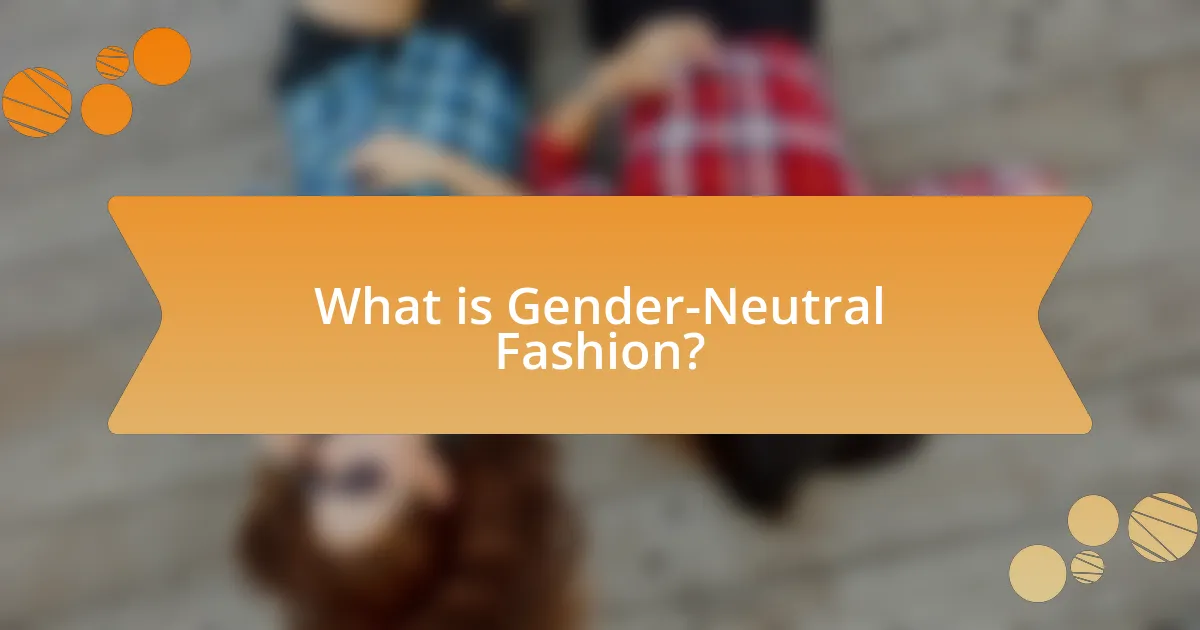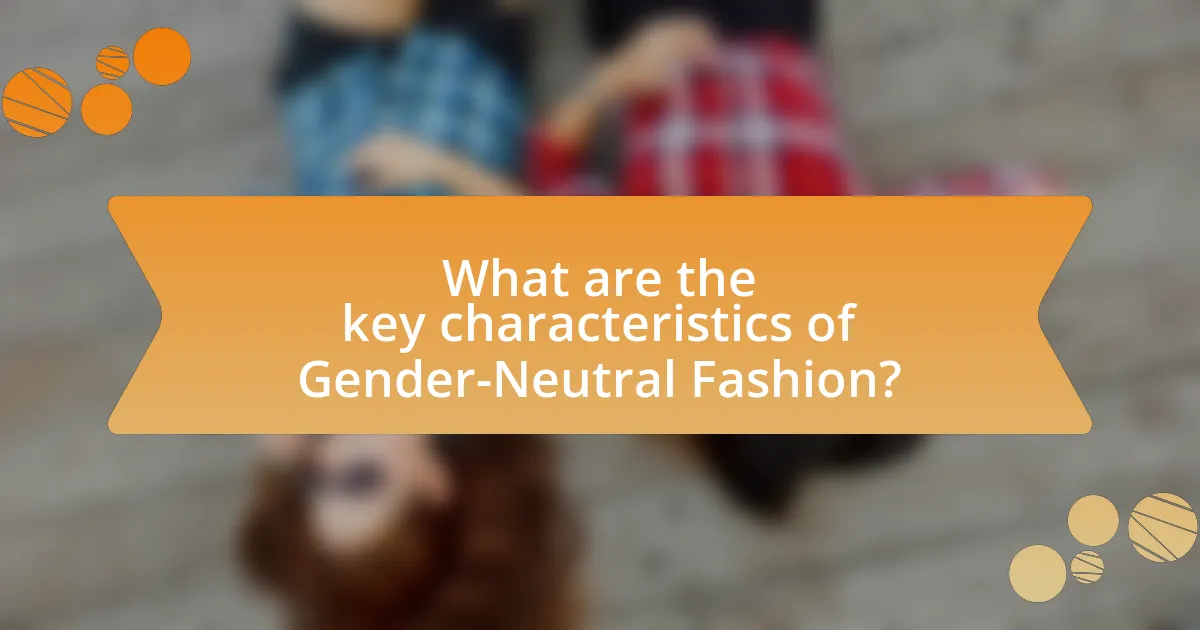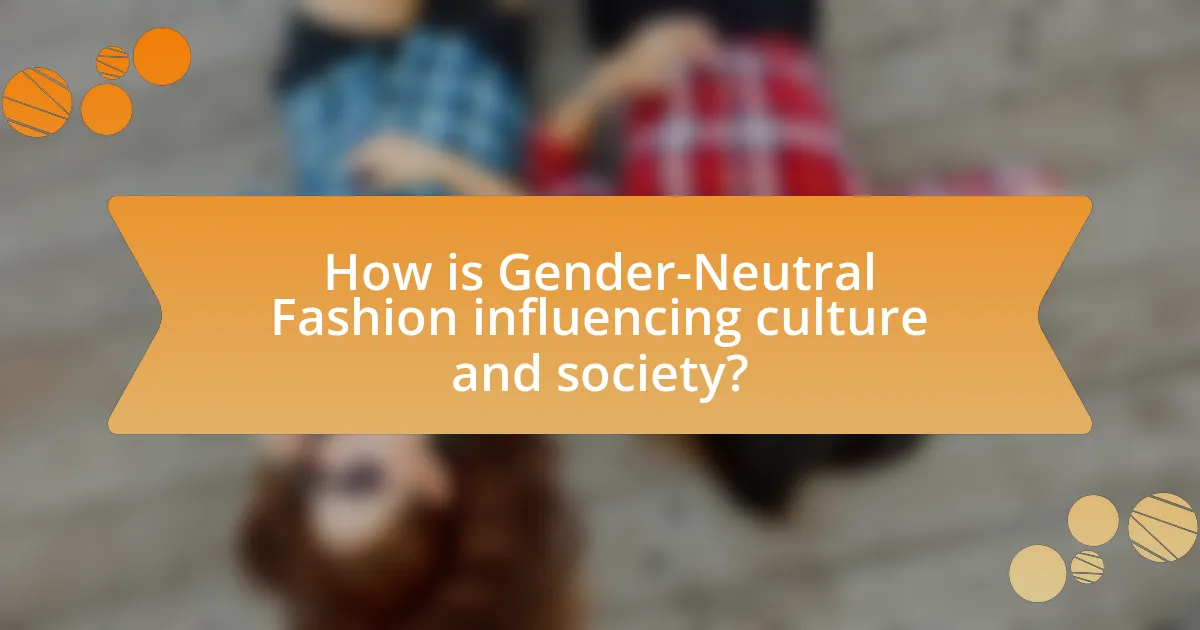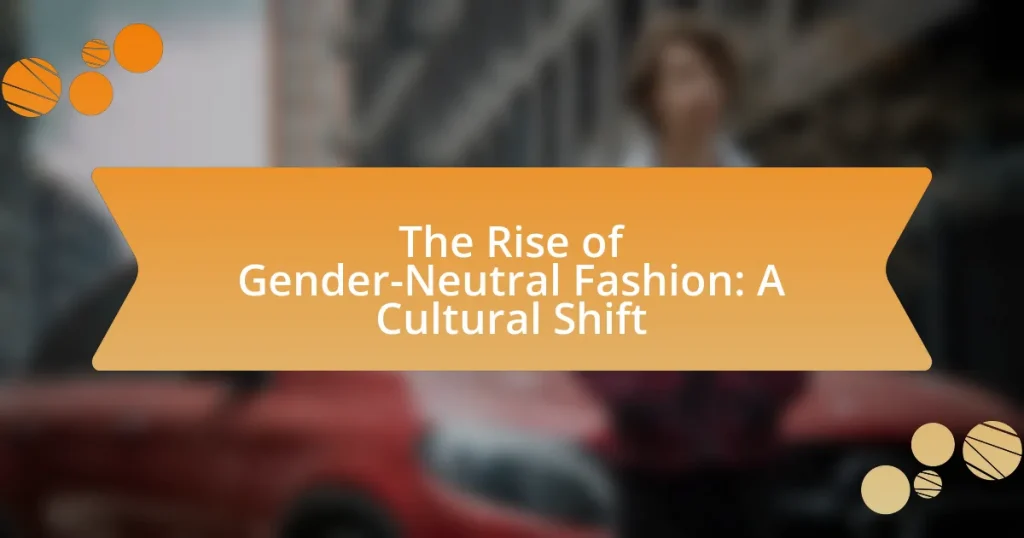Gender-neutral fashion is a clothing movement designed for individuals regardless of their gender identity, promoting inclusivity and challenging traditional gender norms. This article explores the emergence of gender-neutral fashion, tracing its roots to historical events such as the feminist and LGBTQ+ rights movements, and highlights the evolving societal attitudes towards gender and fashion. Key characteristics of gender-neutral fashion include unisex designs, neutral colors, and a focus on comfort, with brands like Telfar and Rad Hourani leading the way. The article also examines the impact of social media and influencers on this trend, consumer responses, and the challenges brands face in adopting gender-neutral offerings, ultimately reflecting a significant cultural shift towards acceptance and diversity in the fashion industry.

What is Gender-Neutral Fashion?
Gender-neutral fashion refers to clothing designed to be worn by individuals regardless of their gender identity, promoting inclusivity and breaking traditional gender norms. This fashion movement emerged in response to societal shifts towards recognizing and accepting diverse gender identities, with brands increasingly offering unisex collections that prioritize comfort and personal expression over conventional gendered styles. The rise of gender-neutral fashion is supported by statistics indicating that a significant portion of consumers, particularly younger generations, prefer brands that embrace inclusivity, reflecting a broader cultural shift towards equality and representation in the fashion industry.
How did Gender-Neutral Fashion emerge as a concept?
Gender-neutral fashion emerged as a concept in response to evolving societal attitudes towards gender identity and expression. The late 20th century saw a significant cultural shift, influenced by movements advocating for LGBTQ+ rights and the rejection of traditional gender norms. Designers began to create clothing that transcended binary classifications, focusing on inclusivity and self-expression rather than adhering to conventional gendered styles. This shift was further propelled by the rise of streetwear and unisex collections from brands like Rad Hourani and Telfar, which emphasized comfort and versatility. The emergence of gender-neutral fashion reflects a broader societal recognition of diverse gender identities, as evidenced by increased visibility in media and fashion shows, signaling a departure from rigid gender roles.
What historical events influenced the rise of Gender-Neutral Fashion?
The rise of gender-neutral fashion has been significantly influenced by historical events such as the feminist movement of the 1960s and 1970s, which challenged traditional gender roles and promoted equality. This movement encouraged women to adopt styles that were previously considered masculine, leading to a blending of gendered clothing. Additionally, the LGBTQ+ rights movement, particularly the Stonewall Riots in 1969, played a crucial role in advocating for gender expression and fluidity, further normalizing non-binary fashion choices. The emergence of androgynous icons in popular culture, such as David Bowie and Prince, also contributed to the acceptance of gender-neutral styles. These events collectively fostered a cultural shift towards inclusivity in fashion, paving the way for contemporary gender-neutral clothing lines.
How have societal attitudes towards gender and fashion evolved?
Societal attitudes towards gender and fashion have evolved significantly, shifting from rigid gender norms to a more inclusive and fluid understanding of identity. Historically, fashion was strictly divided along gender lines, with distinct styles for men and women, often reflecting societal expectations and roles. However, in recent decades, particularly since the late 20th century, there has been a growing acceptance of gender-neutral and unisex clothing, driven by movements advocating for gender equality and LGBTQ+ rights.
This evolution is evidenced by the rise of brands that promote gender-neutral fashion, such as Telfar and Rad Hourani, which challenge traditional gender binaries. Additionally, cultural phenomena like the popularity of androgynous figures in media and fashion, such as Billy Porter and Jaden Smith, have further normalized the blending of gendered styles. Research from the Fashion Institute of Technology indicates that 70% of consumers now support gender-neutral clothing lines, highlighting a significant shift in consumer attitudes. This change reflects broader societal movements towards inclusivity and self-expression, marking a departure from the historical constraints of gendered fashion.
Why is Gender-Neutral Fashion important in today’s society?
Gender-neutral fashion is important in today’s society because it promotes inclusivity and challenges traditional gender norms. This shift allows individuals to express their identity without the constraints of binary gender classifications, fostering a sense of belonging for diverse gender identities. According to a 2021 report by McKinsey & Company, 67% of Gen Z consumers prefer brands that reflect their values, including inclusivity, which highlights the demand for gender-neutral options in the fashion industry. This trend not only supports personal expression but also drives social change by encouraging acceptance and understanding of gender diversity.
What impact does Gender-Neutral Fashion have on identity and self-expression?
Gender-neutral fashion significantly impacts identity and self-expression by allowing individuals to transcend traditional gender norms in clothing. This fashion movement promotes inclusivity, enabling people to express their identities without the constraints of binary gender categories. Research indicates that 62% of consumers prefer brands that offer gender-neutral options, reflecting a societal shift towards acceptance and diversity in personal expression. By embracing gender-neutral styles, individuals can cultivate a sense of authenticity and freedom, fostering a more inclusive environment that celebrates varied identities.
How does Gender-Neutral Fashion challenge traditional gender norms?
Gender-neutral fashion challenges traditional gender norms by promoting clothing that is not restricted by societal expectations of masculinity or femininity. This movement encourages individuals to express their identity through style without conforming to binary gender classifications. For instance, brands like Telfar and Rad Hourani have gained recognition for their unisex designs, which blur the lines between male and female attire. Research indicates that the rise of gender-neutral fashion reflects a broader cultural shift towards inclusivity, as evidenced by a 2021 report from McKinsey & Company, which found that 60% of Gen Z consumers prefer brands that embrace gender fluidity. This shift not only disrupts conventional fashion marketing but also fosters a more accepting environment for diverse gender identities.

What are the key characteristics of Gender-Neutral Fashion?
Gender-neutral fashion is characterized by its inclusivity, versatility, and a rejection of traditional gender norms in clothing. This style emphasizes unisex designs that can be worn by individuals regardless of their gender identity, promoting a more fluid approach to fashion. Key characteristics include the use of neutral colors, relaxed silhouettes, and functional materials that prioritize comfort over gender-specific tailoring. The rise of gender-neutral fashion reflects broader societal changes towards acceptance and diversity, as evidenced by the increasing number of brands and designers, such as Telfar and Rad Hourani, who focus on creating collections that cater to all genders.
How do designs in Gender-Neutral Fashion differ from traditional fashion?
Designs in Gender-Neutral Fashion differ from traditional fashion primarily by eliminating gender-specific silhouettes and styles, focusing instead on inclusivity and versatility. Traditional fashion often adheres to binary gender norms, with distinct clothing lines for men and women characterized by specific cuts, colors, and patterns. In contrast, gender-neutral fashion embraces a more fluid approach, utilizing unisex designs, neutral colors, and adaptable fits that cater to a broader audience. This shift is supported by the growing demand for inclusivity in the fashion industry, as evidenced by a 2021 report from McKinsey & Company, which highlighted that 60% of consumers prefer brands that promote gender inclusivity.
What materials and styles are commonly used in Gender-Neutral Fashion?
Gender-neutral fashion commonly utilizes materials such as cotton, linen, and jersey, alongside styles like oversized silhouettes, unstructured tailoring, and minimalist designs. These materials are favored for their versatility and comfort, allowing for a wide range of body types and personal expressions. The styles emphasize functionality and inclusivity, often featuring neutral colors and gender-neutral cuts that appeal to diverse audiences. This approach aligns with the growing demand for clothing that transcends traditional gender norms, reflecting a cultural shift towards acceptance and individuality in fashion.
How does sizing work in Gender-Neutral Fashion?
Sizing in gender-neutral fashion typically employs a unisex or size-inclusive approach, allowing garments to fit a broader range of body types regardless of gender. This system often utilizes standard measurements that focus on key dimensions such as chest, waist, and hip sizes, rather than traditional gender-specific sizing. For example, brands may offer sizes labeled as small, medium, large, etc., without gender distinctions, promoting inclusivity. This method is supported by the growing demand for clothing that accommodates diverse body shapes and sizes, reflecting a cultural shift towards acceptance and representation in fashion.
What brands are leading the way in Gender-Neutral Fashion?
Brands leading the way in gender-neutral fashion include Telfar, Rad Hourani, and Gender Free World. Telfar is known for its inclusive designs and unisex bags, which have gained significant popularity and recognition in the fashion industry. Rad Hourani focuses on unisex clothing that transcends traditional gender norms, emphasizing versatility and individuality. Gender Free World offers a range of clothing that is explicitly designed to be gender-neutral, promoting inclusivity in fashion. These brands exemplify the cultural shift towards gender-neutral fashion by challenging conventional gender binaries and catering to a diverse audience.
Which designers are known for their contributions to Gender-Neutral Fashion?
Designers known for their contributions to gender-neutral fashion include Rad Hourani, Telfar Clemens, and Maison Margiela. Rad Hourani is recognized for pioneering unisex designs that challenge traditional gender norms in clothing. Telfar Clemens has gained acclaim for his inclusive approach, particularly with the “Bushwick Birkin” bag, which emphasizes accessibility and gender fluidity. Maison Margiela, under the creative direction of John Galliano, has also embraced gender-neutral aesthetics, often blurring the lines between menswear and womenswear in its collections. These designers have significantly influenced the cultural shift towards gender-neutral fashion by promoting inclusivity and challenging conventional gender binaries in the fashion industry.
How are mainstream brands adapting to the Gender-Neutral trend?
Mainstream brands are adapting to the gender-neutral trend by expanding their product lines to include unisex clothing and accessories. For instance, brands like Zara and H&M have introduced collections that feature gender-neutral designs, reflecting a shift in consumer demand for inclusivity. Additionally, major retailers are re-evaluating their marketing strategies to promote these collections without gender-specific labels, thereby appealing to a broader audience. This adaptation is supported by market research indicating that 56% of Gen Z consumers prefer brands that offer gender-neutral options, highlighting the growing importance of inclusivity in fashion.

How is Gender-Neutral Fashion influencing culture and society?
Gender-neutral fashion is influencing culture and society by challenging traditional gender norms and promoting inclusivity. This shift allows individuals to express their identities beyond binary classifications, fostering a more accepting environment. For instance, brands like Telfar and Palomo Spain have gained recognition for their unisex designs, which cater to a diverse audience and reflect changing societal attitudes towards gender. According to a 2021 report by McKinsey & Company, 60% of consumers are more likely to support brands that embrace gender inclusivity, indicating a significant cultural impact. This trend not only reshapes fashion but also encourages broader discussions about gender identity and expression in everyday life.
What role does social media play in the rise of Gender-Neutral Fashion?
Social media significantly influences the rise of gender-neutral fashion by providing a platform for diverse voices and styles to gain visibility. This visibility allows brands and individuals to challenge traditional gender norms, promoting inclusivity and acceptance in fashion. For instance, campaigns on platforms like Instagram and TikTok showcase gender-neutral collections, reaching millions and encouraging consumers to embrace non-binary styles. Additionally, social media facilitates community building among advocates of gender-neutral fashion, fostering discussions that further normalize these concepts. The impact is evident, as brands that adopt gender-neutral lines often see increased engagement and sales, reflecting a shift in consumer preferences towards more inclusive fashion options.
How are influencers shaping perceptions of Gender-Neutral Fashion?
Influencers are significantly shaping perceptions of gender-neutral fashion by promoting inclusivity and challenging traditional gender norms. Through social media platforms, influencers showcase diverse styles that blend masculine and feminine elements, making gender-neutral clothing more accessible and appealing to a broader audience. For instance, influencers like Jaden Smith and Emma Chamberlain have garnered attention for their gender-fluid fashion choices, which resonate with younger generations seeking self-expression beyond binary classifications. This visibility not only normalizes gender-neutral fashion but also encourages brands to expand their offerings, as evidenced by the rise of collections from major retailers that cater to this demographic.
What trends are emerging from the Gender-Neutral Fashion movement?
Emerging trends from the Gender-Neutral Fashion movement include the rise of unisex clothing lines, increased use of neutral colors, and a focus on comfort and functionality over traditional gender norms. Unisex clothing lines, such as those launched by brands like Telfar and Rad Hourani, challenge conventional gendered fashion by offering styles that appeal to all genders. The use of neutral colors, such as beige, gray, and black, is becoming more prevalent, reflecting a shift away from gender-specific palettes. Additionally, the emphasis on comfort and functionality is evident in the popularity of oversized silhouettes and athleisure wear, which prioritize wearability over traditional gendered aesthetics. These trends signify a broader cultural shift towards inclusivity and self-expression in fashion.
What challenges does Gender-Neutral Fashion face in the industry?
Gender-neutral fashion faces significant challenges in the industry, primarily due to entrenched gender norms and market segmentation. Traditional fashion marketing often relies on binary gender categories, making it difficult for gender-neutral brands to gain visibility and acceptance. Additionally, consumer resistance to abandoning established gendered clothing norms can hinder sales and brand loyalty. According to a 2021 report by McKinsey & Company, only 20% of consumers are willing to embrace gender-neutral clothing, indicating a substantial gap in market readiness. Furthermore, supply chain issues and limited production capabilities for gender-neutral items can restrict availability and variety, complicating the efforts of brands aiming to cater to this emerging market.
How do consumers respond to Gender-Neutral Fashion offerings?
Consumers generally respond positively to gender-neutral fashion offerings, appreciating the inclusivity and diversity these products represent. A survey conducted by the market research firm Mintel in 2021 revealed that 62% of consumers are interested in gender-neutral clothing, indicating a significant demand for such options. This response is driven by a growing cultural shift towards breaking traditional gender norms, with many consumers valuing brands that promote equality and self-expression. Additionally, the rise of social media has amplified awareness and acceptance of gender-neutral fashion, further influencing consumer preferences and purchasing behaviors.
What barriers exist for brands trying to adopt Gender-Neutral Fashion?
Brands face several barriers when trying to adopt gender-neutral fashion, including societal norms, market demand, and supply chain limitations. Societal norms often dictate traditional gender roles, making it challenging for brands to shift consumer perceptions towards gender-neutral options. Market demand can be inconsistent, as some consumers may still prefer gender-specific clothing, leading to hesitation from brands to invest in gender-neutral lines. Additionally, supply chain limitations, such as sourcing materials and manufacturing processes that accommodate diverse sizing and styles, can complicate the implementation of gender-neutral fashion. These barriers collectively hinder the widespread adoption of gender-neutral clothing in the fashion industry.
What practical tips can consumers follow when exploring Gender-Neutral Fashion?
Consumers exploring gender-neutral fashion should prioritize versatility in their wardrobe choices. Selecting clothing items that can be styled in multiple ways allows for greater expression and adaptability. For instance, unisex pieces such as oversized shirts, tailored trousers, and neutral-toned outerwear can be combined to create various looks suitable for different occasions. Additionally, consumers should consider fit over traditional gender sizing; many brands now offer gender-neutral sizing charts that focus on body measurements rather than gender labels. This approach not only enhances comfort but also promotes inclusivity. Research indicates that the global market for gender-neutral clothing is growing, reflecting a cultural shift towards acceptance and diversity in fashion.



